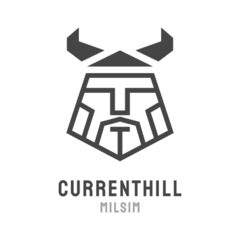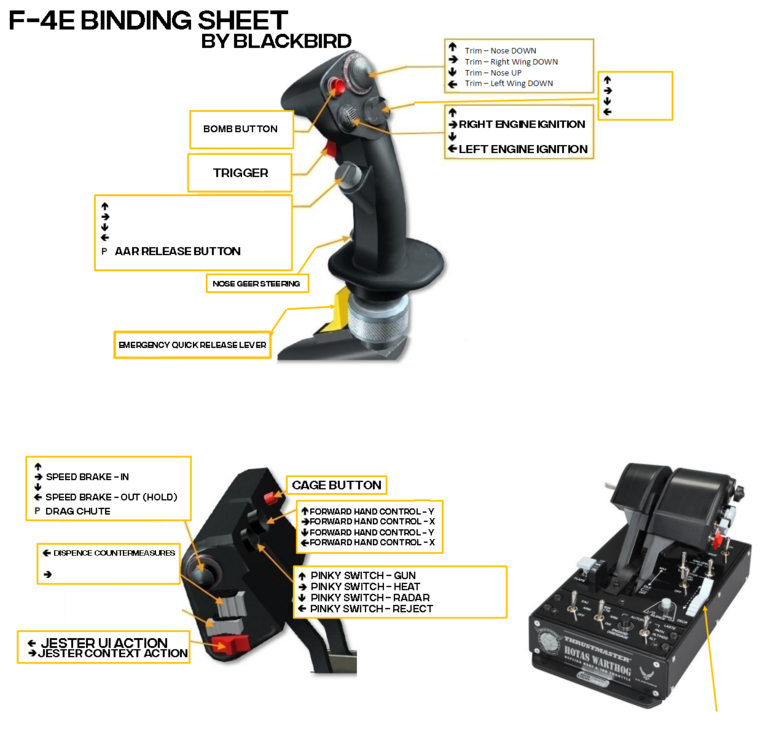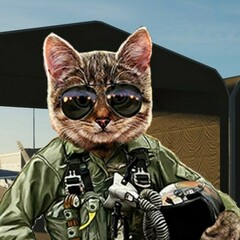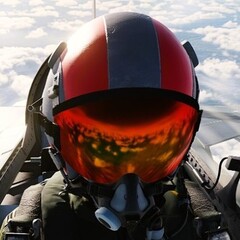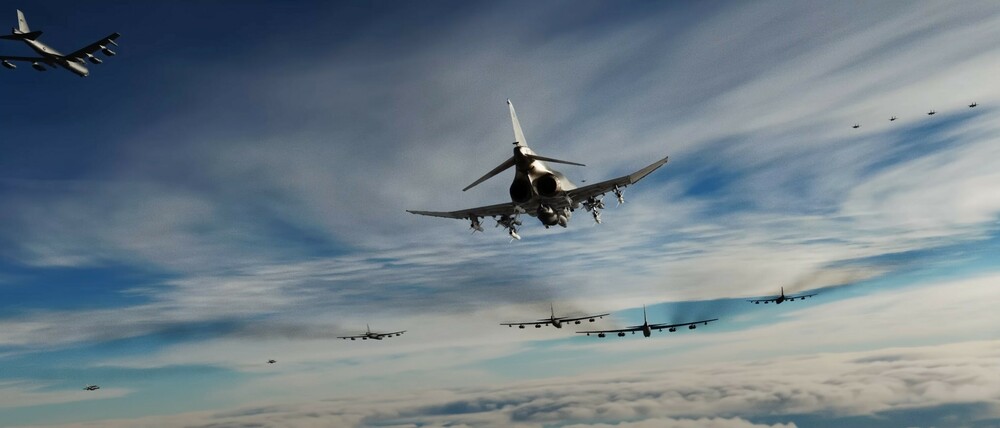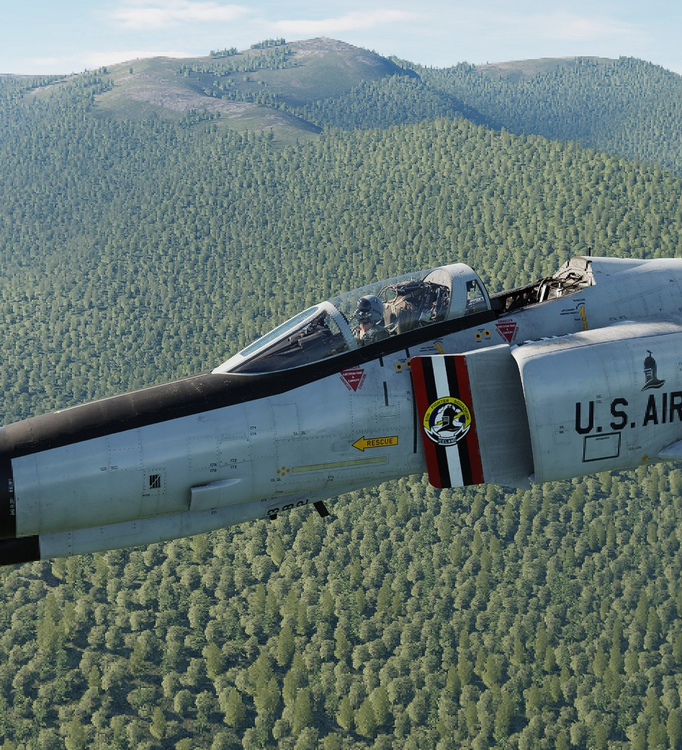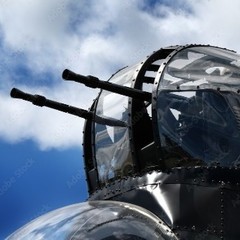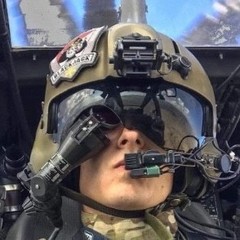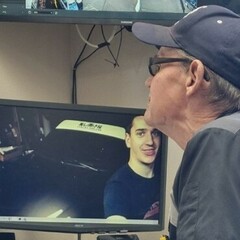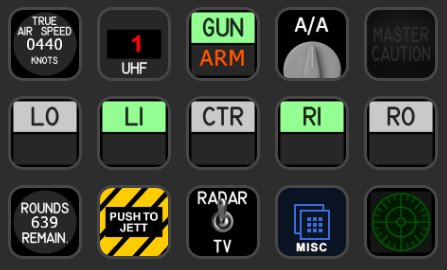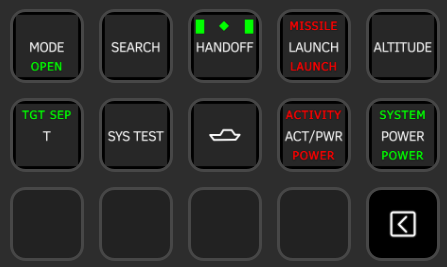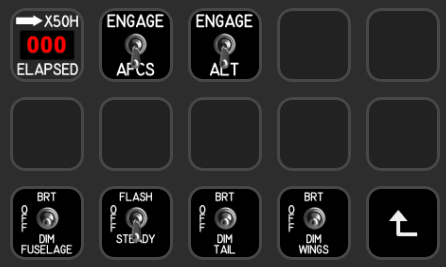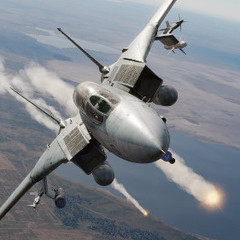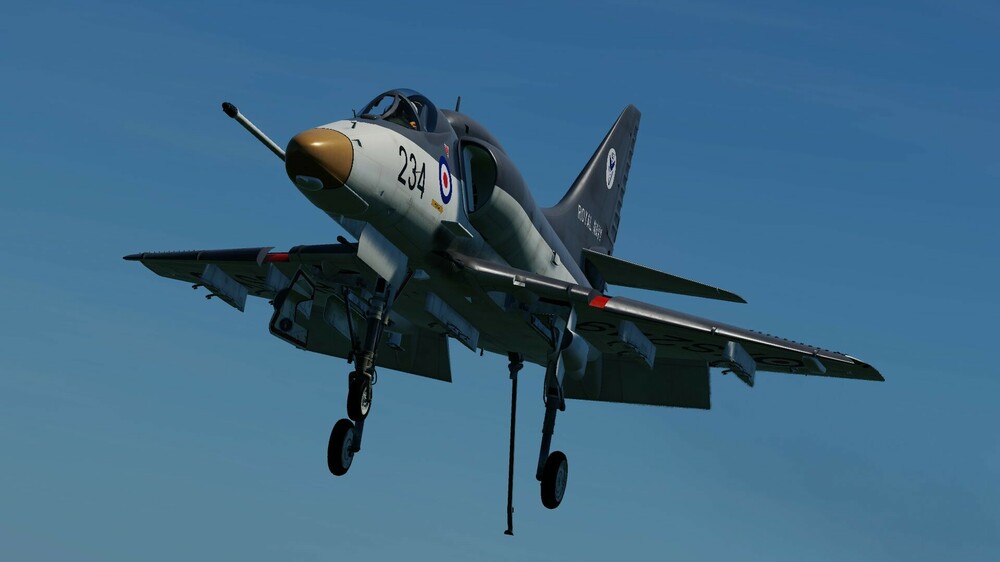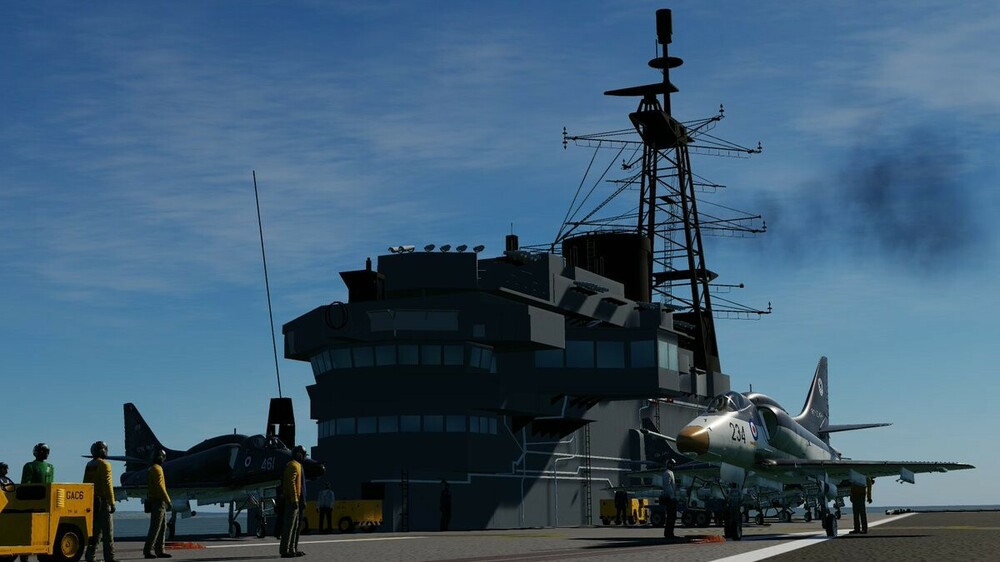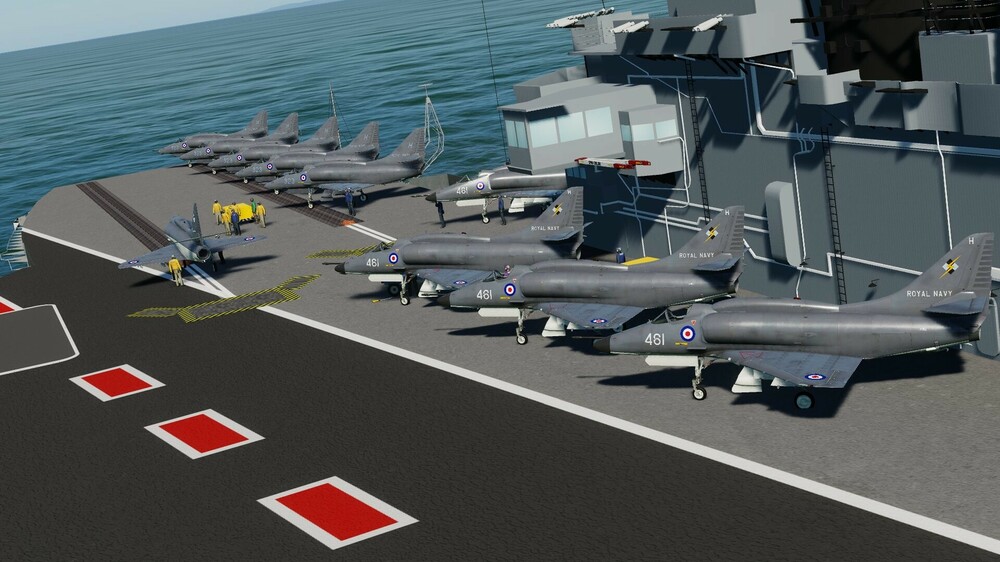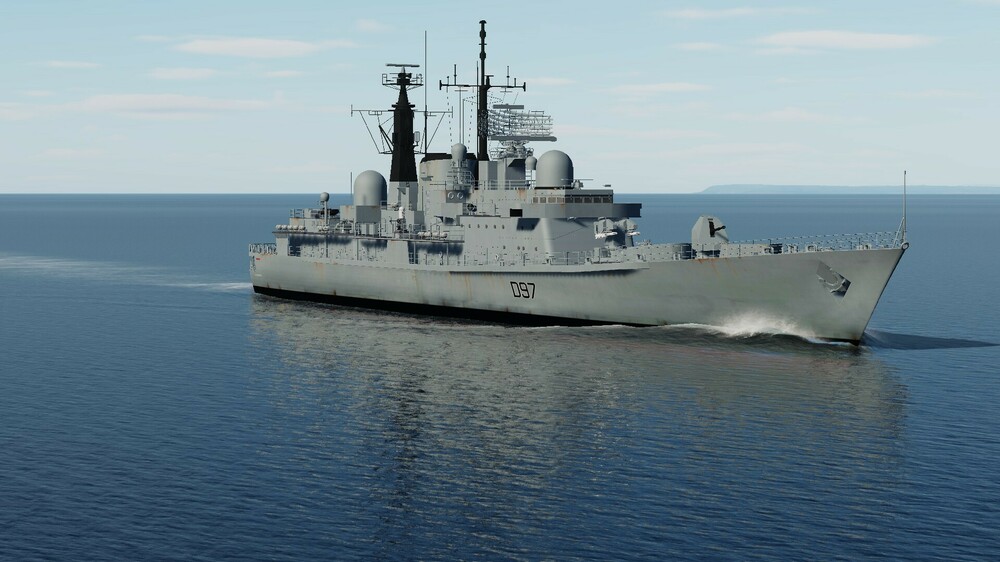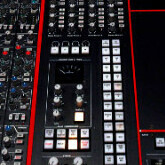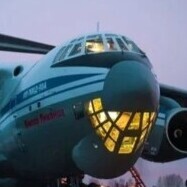Leaderboard
Popular Content
Showing content with the highest reputation on 05/23/24 in Posts
-
Dear all, gathering your questions and most pressing concerns and feedback from yesterday, we want to present you with a list of issues you may run into, when trying the F-4E for the first time, and ways on how to avoid them. We hope the below list helps you get started faster and smoother. Please spread the word! Your Heatblur Team Issue: I am experiencing bad performance with the F-4E. Fix: Make sure you are using the multithreaded version of DCS, not the singlethreaded. This will significantly improve your performance. We do not recommend running the F-4 in the singlethreaded version. You already have both versions installed, always. To run the multithreaded version simply run the DCS.exe in your Eagle Dynamics\DCS World\bin-mt folder. Issue: My F-4E keeps pitching up violently although my controls are bound correctly. Fix: This happens to non-FFB users who have FFB enabled in their MISC options. Simply go to MISC options and disable FFB and the issue will go away. Issue: I am using VR and the JESTER Menu, Manual and/or Bombing Calculator are cut off. Fix 1: It is an issue with the DCS VR implementation and an unfortunate combination of graphic settings. You can fix it either by selecting "use dcs internal resolution" in your VR settings or using our special options if you don’t want to do that. It is described further in this section of our manual: https://f4.manuals.heatblur.se/dcs/special_options.html#hb-ui Fix 2: As stated in the manual, setting the VR render window to LEFT or RIGHT eye without checking the "Use DCS resolution" box makes the Jester menu cut off. However if "Use DCS resolution" (fix 1) alone does not solve it for you, you can try to use the "BOTH" setting for the redering option. Jester menu should then be back in full, normal size and centered. Fix 3: Found by Des 2-2 (thank you!): "an (easy) solution to the HBUI cut off at the bottom in VR issue: change the resolution of the VR mirror to at least 1920x1080. Many people set it below that in the hope that it frees up a little GPU resources." Note: We are currently trying to find a solution together with ED. In the meantime, if neither fix 1 nor fix 2 work for you, the best is to experiment with the resolution settings offered in the special options. Our apologies. Issue: I downloaded and installed via the DCS module manager, but when I spawn in the mission, it goes to the F10 map and only AI spawns. Fix + EDIT: Going through the reports of the past few days and fixes that were found, most likely this issues is because your antivir program is either blocking HBUI.exe or one of our DLLs. We kindly ask you to add exceptions to these in your antivir program. This should fix your issue. If the issue persists, please make a report. Issue: When I go to the mission editor, I do not see the F-4E. Fix: You need to turn off the “historical setting” in the Mission Editor. It is at the bottom center, represented by a clock symbol. Click the clock symbol to turn it off. Issue: My JESTER menu gets stuck. Fix: If using head tracking and mouse at the same time, they can conflict. You can disable either in the special options settings for the F-4E. Moving the mouse pointer out of the menu fixes it, too. To close the menu you can hold the Jester menu button long. Issue: My force feedback pitch and roll force seems very light or weak. Fix: You have gain settings for force feedback in the special menu options. Note that you can increase them to 500%. Note that if both roll and pitch axis are set to the same value, the roll axis will have less force feedback force. This is intentional and true to the real aircraft, where the roll axis requires less input force than the pitch axis. Please adjust to your personal preferences. Issue: It looks like the stick in my cockpit is lagging in comparison to my real stick. Fix: The movement of the 3d model of the stick in the cockpit goes through a type of low-pass-like filter. Otherwise, it might look erratic and actually even less realistic. However, it doesn't represent the actual physical simulation of the entire stick simulation, and that means that the change of your input is instantaneously transferred to the controls system. Yet, that system runs a complex simulation that adds realistic inertia to the mechanisms that transfer your input to the power actuators. To summarise, the lag you may see when observing the 3D controls doesn't represent the system's delay; there might be some realistic inertia reducing the controls' responsiveness. Issue: I want to close the manual or bomb calculator, but it does not work. Fix: You need to click with the mouse out of the manual or bomb calc window. If clicked into it, keyboard input is enabled and will prevent the close/open commands. Issue: My cockpit appears to be very dark. Fix: Please make sure that you have “Cockpit Global Illumination” turned ON. If this alone does not help, our recommended Gamma setting is 2.2, so you may want to increase your Gamma. Note: there is currently a bug that will load the cockpit darker on the second spawn. A third spawn should fix that. Issue: My trim is not working on the ground, the stick is either full forward or full back and when I trim it does not change position. Fix: This is correct as is on the ground. The bellows system pulls at the stick with increasing airspeed, while the bobweight system pushes the stick forward with increasing G. In flight and when you are trimmed out well, these forces roughly balance each other out naturally. On ground however, the bellows measure airspeed 0 and hence do not add any force that would counter the bobweight system pushing the stick forward. You also will not see trim doing anything in that situation, since the trimming merely changes the length of the lever to which the bellows can apply force to the stick and do not move the stick around directly. Issue: I cannot make sense of the controls indicator. Fix: The big green diamond is your joystick input. The small green diamond is the neutral in-cockpit stick position - this is where the cockpit stick will reset if you re-centre your joystick. The orange/red diamond represents the actual cockpit stick position after taking into account all effects, including your joystick input, the feel trim system, force limiting, and blending. This position is transferred to the power actuators moving the control surfaces. Issue: I have trouble getting used to JESTER 2.0 and the new menu. Fix: We recommend giving it a few days to get used to it. Jester 2.0 is designed more proactive than JESTER 1.0, he scans the sky himself for example, he will turn radar on and off himself if landing or refueling, etc., and overall requires less use of the menu through the JESTER context action. With context action you can direct him to switch targets, lock them, unlock them in air to air, to lock ground returns for dive toss, and more. We recommend to familiarize yourselves with the JESTER section in our manual in general, here: https://f4.manuals.heatblur.se/jester/overview.html And with the JESTER combat section in regards to context action, here: https://f4.manuals.heatblur.se/jester/combat/overview.html Issue: Jester has trouble finding targets. Fix: While Jester searches the sky in a forward, primarily head-on, co-alt aspect of your radar, one still needs to consider the limitations of the AN/APQ-120 radar. It is not a search radar, and the detection ranges are very short. This means that with 2 bandits racing at each other, from detection to merge, your BVR timeline can be less than 45 seconds. IRL Phantoms were guided to their target’s general position with the help of GCI and AWACS units. The F-4E’s radar is also a radar that needs to be “flown” pro-actively. This means helping it through your maneuvering - or non-maneuvering - as much as you can. Look-up aspect is in general preferable, so positioning yourself slightly below the bandit helps. Some bandits with a smaller cross section, like the MiG-19 may be picked up by the radar at less than 20 nm. In short: try to use the radar more as an intercept radar than a search radar. Try to estimate where you targets will be, either through conventional SA building or through the aid of GCI and AWACS, and then position yourself for a successful intercept. If you want to dive deeper into the topic, we recommend Karon’s tutorials on youtube, from FlyAndWire. Issue: I am encountering weird behavior, like some weapons not working, or even get a CTD when trying to host a server, etc. Fix: This is likely owed to the presence of mods. As of now, the only mod we know that works together with the DCS: F-4E Phantom II for certain is the Community A-4 mod. Any other mod can potentially cause issues of various kinds. This is why we strongly recommend to disable all your mods, should you be running into such issues. ED is aware of the potential conflicts between modules and mods and will be looking into it. Please be so kind and understand that full functionality of the module cannot be guaranteed when running it with mods. Thank you! A tip from user “Mederlock” to improve performance, if running into issues: “A little tip that might help some people's performance: in the task manager details page, dcs.exe->set affinity->de-select the first core. If you check the DCS log file you can even see which of your cores perform the worst and de-select those specifically. You'll have to re-do this every time you launch the game or use a tool like process lasso to automate it on startup. I've heard a few reasons why this can help, [...], I don't really know the theory but it certainly helped my performance a lot, as well as several other people in the group I play with. Worth a shot if you're having stuttery or poor performance.” Check out these beginner tipps and tricks from Tricker: Here is also a nice cheat sheet for WH key binds, made by Blackbird (as a proposal). You can also check out the control bindings guide in our manual here: https://f4.manuals.heatblur.se/dcs/controls.html#binding-guide21 points
-
Hello everyone, My name is Krzysztof Sobczak (some of you may know me as “Grover”), I am the Technical Director at Heatblur. Although I haven't been very involved in direct communication with our users because I have been focusing on working hard on our projects, today, I am excited to share some technical insights about our latest release. As some of you may read from me for the first time, I'll start with a short introduction: I am originally a physicist holding a PhD in particle physics. However, most of my professional life has been dedicated to developing flight simulations. I have had the privilege of working with companies like A2A Simulations and Metrea. In 2018, I joined Heatblur Simulations to work on the F-14 Tomcat. During this project, my areas of responsibility included the communication and navigation systems, the LANTIRN targeting pod, and JESTER LANTIRN. In 2021, I became the Technical Director to create a new core system - codename Anvil - a genuinely new-generation simulation platform. Having been involved in creating several flight simulation engines throughout my career, I have gained a deep understanding of the requirements for such engines and the shortcomings of existing solutions. This extensive experience has been invaluable in shaping the form of our new flight simulation platform, which we present today through the release of the Heatblur F-4E Phantom II. Our users may already be familiar with the innovative approach we applied in the F-4E Phantom II, particularly the concept of the components system. For those with programming experience, this might initially sound like a marketing trick, similar to object-oriented programming and using objects through composition in different contexts to build complex structures. However, there is much more depth to the system we created. Our approach goes beyond simple object composition and reuse. What sets our system apart from other solutions and programming techniques is its orientation around data flow. This focus is crucial for creating a system that is both reusable and granular enough to build entire aircraft and reuse components in other aircraft or systems. The challenge in making such a system lies in the uniqueness of many aircraft devices, so to achieve true reusability, we had to reach deep to a level where components can be generalized - the level of individual switches, relays, lamps, amplifiers, actuators, valves, and all other kinds of low-level components. By focusing on the components and the data flow between them through the connections, we managed to move all non-simulation elements outside the components and let Anvil handle them. The first core aspect of our F-4E Phantom II, driven by our engine, is its multi-crew capability. The component connection approach allows our developers to focus entirely on creating the simulation part of each component. At the same time, the system handles the communication between different components and distributes it over the network. From the developer's perspective, there is no difference between developing an aircraft simulated entirely on one computer and an aircraft whose simulation is spread across multiple computers. The second feature unlocked by the component system is multi-threading. By strictly separating components from each other and not allowing them to access other components directly, we ensure that the simulation part of each component can run concurrently. This approach means that developers do not have to worry about the complexities of multi-threaded development and can work as if the simulation of each component were entirely single-threaded. The connection system governs the rest — it de-conflicts multiple simulation threads seamlessly. It is important to note that while our system is designed to support multi-threading, this feature is not enabled in the version that users are receiving today to limit the risks of the adverse effects for the premiere of such a complex aircraft. However, multi-threading will be enabled in future updates, offering a significant boost in performance for everyone. Also, note that this is not the same as using the multi-threaded version of DCS - the multi-threading part of our component system adds another layer of parallelization, effectively offloading the aircraft simulation from the main DCS thread. The component system is oriented toward providing developers with the tools to create new components quickly and efficiently. With those tools, we can focus on recreating components' real-life properties and giving them an organic feel by adding imperfections, individual characteristics and failures that can occur as a natural result based on the treatment of the components. Later, we use those components as bricks to build the aircraft in a fully synthetic way, while Anvil makes each airframe unique and each flight a new adventure while giving virtual pilots an incentive to not mistreat the aircraft. Finally, we plan to use Anvil and the same library of base components in all our future products, retrofitting them to the already published products where applicable. Sharing the same code will ensure that all our future aircraft will be automatically updated with our latest achievements and changes introduced to the system while developing any new product. This means that from now on, our simulation can only get more profound and more realistic. After introducing key features of the component system, let's delve into some statistics about DCS F-4E Phantom II. The total count of components used in our simulation, as in the final build provided to Eagle Dynamics, is 6,389. We used 14,627 component connections. Out of these, 2,297 connections are synchronized in multi-crew. The total number of properties across all components is 34,964, with 25,032 of these properties synchronized in multi-crew. Many of these properties are randomized and depend on the wear and condition of the aircraft. Finally, the total count of all damaged states in the aircraft is 1,562. While this number is already high, we plan to implement many more new failures during the early access period. Some of you might be concerned about the costs of creating detailed products like our F-4E Phantom II, which could negatively impact the entire market. We never intended that, and we are confident this won't happen. First of all, our goal was to make the development of complex modules less expensive by improving the reusability of the code and offloading most of the low-level and repetitive development to Anvil, which will handle it automatically. Furthermore, we are part of the flight-sim community and want the study-level flight simulation to thrive. From the first days of this new platform, we shaped it in the form of SDK, which we want to offer our partners. This includes the entire library of components and JESTER. We believe that cooperation and fostering synergies is more creative and profitable than non-amicable competition. As you will be able to experience the F-4E Phantom II for DCS yourself, I hope you will enjoy every minute spent in our recreation of this magnificent aircraft. On behalf of the entire team, thank you for the support and excitement you express daily through all communication channels. Have fun!15 points
-
Status update Military Asset Pack Germany I'm around 75% done with the Germany pack updates. There will be a total of around 15+ new assets in the upcoming release. Missile issues with DCS 2.9.5.55300 I also noticed issues with some of my missiles with the latest DCS update. ED has changed some core parameters which mean I have to create fix updates for all packs containing modern missiles. I will make these updates incremental as they only need to update some of the code. It looks like it's the missile thrust vectoring that's completely changed. The fixes will unfortunately take a lot of time and I will have to release fix updates for the following country packs: China Russia Sweden UK USA This will put the Germany asset pack update on hold for now.15 points
-
Dear all, the moment has finally come. We thank you all for your incredibly kind patience, for sticking with us. Not much remains to say, other than we really hope you enjoy it. As usual, we ask you for your kind feedback, for the Phantom, for the very first time. Your Heatblur Team13 points
-
Thank you all for the very kind words and valuable feedback. We are happy that you like it. Our apologies for those of you who are running into issues here and there, I will put up a small thread tomorrow "How to avoid possible issue" including stuff like FFB off for non FFB guys, VR menu cut off, trim not working on the ground etc. Luckily though, most of what I have read so far is avoidable with some minor tweaking. As for those who seem to have a bit more struggle with VR performance, please be so kind and share you specs and settings, it helps us to investigate further. We are of course also seeing some minor bugs here and there and we are already preparing a hotfix to address the most urgent stuff in the next few days and then hopefully more next week. Thank you all again, please continue giving us feedback.9 points
-
Surviving FAM-1 in the Phantom. Congratulations on your purchase of the F-4E Phantom II. It is a sweet flying beast, with enormous depth and versatility. It’s easy to fly while being tactically challenging. The aircraft is versatile, and the era it dominated was interesting, a combination that produces hours upon hours of engaging fun. First, don’t be intimidated by the hulking beast. The surprising little secret is that it’s easy to fly. The Phantom is honest and uncomplicated procedurally, the engines are responsive and powerful, and the slats make it feel responsive, but also stable and precise. You point it where you want to go, push the throttles up and man, does it go! As you would expect, Heatblur has delved deep into accurate modeling of systems and aerodynamics, and the result is a nuanced, detailed simulation of the F-4E. You will discover small details as you explore the aircraft and systems, they’ve even simulated the influence of engine exhaust flow on the stabilator due to its anhedral. How cool is that? From broad testing experience and SME feedback, I recommend starting with a pitch curve of at least 10 for the F-4. The simulator is faithful to the real F4E, which is sensitive in pitch. Experiment and refine your axis tuning for your controller from there. I am currently using a non-FFB stick with a 4 inch extension and heavy spring tension, 12 works for me. Map your controls. You only need pitch, roll, rudders, brakes, gear, flaps, nose wheel steering, speed brakes, trim in all axis and drag chute for this hop. Keyboard and clicking will be fine for the rest. We won’t be killing MiGs just yet. This guide is meant to be a quick and dirty “FAM-1” guide to get you in the air and safely back to earth. We’ll also have some fun in between. I know you’re eager to give it a try, so skip startup and begin on the runway, ready to launch. Fly a clean jet today, or throw on a centerline drop tank for starters. The trim will already be set (understand that due to the way the bellows/trim system interacts, until airspeed increases, the stabilator will be positioned full leading edge down on the ground), engines running, check that the flaps are down, let’s go. Normal Takeoff and Climb. Apply full afterburner, position stick full aft when Jester calls 80 knots and hold it there. Nose-wheel steering until the rudder becomes effective ~70KIAS (the NWS button must be held during operation). If you drift and need nose-wheel steering to correct, then center the rudder pedals before re-engaging. With full aft stick, the aircraft will rotate on its own when it’s ready to fly, ease off back stick to hold it at 10-12º nose up pitch attitude. Our intrepid F-4 SME’s and and recommended this technique, it works beautifully. Gear and flaps up immediately to avoid overspeed. Both have limit speeds of 250 KIAS. Min flap retract is 180 KIAS, which is only a consideration during military power takeoffs. Jester will let you know when they’re up. Terminate burner at 300 KIAS. You’re in the air, easy peasy, nothing to it. Climb at 350 to intercept .9 Mach. Mil power climbs at 350 KIAS initially require just over 20º of pitch. In Max afterburner, it will climb into the mid twenties at .9 Mach at over 30º nose high. Beast mode. Setting 3000 pph per engine results in a cruise Mach between .84 at FL 250 and .90 at FL350. That’s a fuel burn of 100 pounds per minute. Fuel planning couldn’t be simpler. Mil power at FL350 tops out just below Mach, around .97 IMN. Ease the nose down and it will go supersonic without afterburner. There is a little Mach Tuck going through transonic. Overall, the pitch changes are mild, trim is sensitive. Be quick with your thumb. Operationally, the F-4E is a Mach 2 aircraft. In level flight, it’s fastest at 35,000, and can achieve the dash one charted speed of just over Mach 2. Unload in a dive, and if you sport an adequate moustache, you can hit 2.2 plus. You can have fun figuring out the profile for that for yourself. At sea level, a low drag configuration tops out at 1.12-1.15 IMN. Adding external stores will reduce max Mach proportionately. Maneuvering Flight ROLL AUG off for maneuvering. Always roll using coordinated rudder and aileron. The higher the AOA, feed in more rudder as ailerons are less effective. Rudder only rolls are smooth and predictable. Reducing AOA increases roll rate. Experiment at different AOA’s and speeds, it will come to you quickly. Best sustained turns with typical Air to Air load outs at medium combat altitudes (SL to 15,000) range from 520-480 KIAS. Even with light pitch forces, flying a consistent, sustained turn is relatively easy. Smooth corrections pay big dividends. Control bank angle primarily with your feet. I checked the sustained turn G capability today from SL to 15,000 MSL, and it’s on the money. Gross weight affects performance of course, but if you’re doing your part, you’ll be able to hold 7.0 G on the deck, and 5.1 G while turning level at 15,000 MSL. I’m quite impressed with how stable the Phantom is at high G loads. You can already sense that the F-4E needs and loves airspeed. Use a 500 KIAS entry speed for a mil power loop, 450 with burner. A 4-5G pull up to 19.2 units will result in 200-230 knots or so over the top. It takes a lot of intentional baffoonery at very low speeds to depart controlled flight, which commonly shows up as a nose slice opposite to the direction of aileron input. The recovery controls are neutralize ailerons and rudder, unload with stick well forward (5 degrees AOA is a good target), and pull the throttles back to idle power. If the engines compressor stall, no big deal, go to idle, they recover quickly. Continue to hold up to full forward stick and let the aircraft do what it wants to do during post stall gyrations. As nose falls below horizon, and speed increases to 200 knots, you are flying again, so it’s safe to carefully roll with rudder and aileron to wings level, then pull up in light buffet, approximately 17 units, don’t exceed 19.2 units in the pullout. Spin recovery controls are rudder opposite the yaw/turn needle and lateral stick into (the primary recovery control is aileron), but perhaps the biggest shock having heard all of the lore, it is difficult to get the slatted F-4E to spin, even intentionally. That said, if the aircraft doesn’t recover, pull the drag chute. The aircraft will pitch nose down and accelerate. Either jettison the chute or let it fail when airspeed exceeds ~250knots. If you see a nose slice, it’s probably the ailerons causing it. Center the stick, reduce the angle of attack. The AJB-7 attitude indicator is so well designed that it can be used to fly precise aerobatic maneuvers, including rolling out on a specific heading, without looking outside the cockpit. The indicator is surrounded by the primary flight instruments, so in addition to the heading marks on the AJB-7 itself, you can see airspeed, AOA, altitude and the VSI in your peripheral vision, without shifting your scan. It’s all right there. Try this. Referencing the attitude indicator, pull up wings level and peg the nose exactly in the middle of the black dot that depicts 90º up, then pull the throttles to idle and do a lovely tail slide. If you get it right, the aircraft will back down, and full aft stick will make it flop forward, full forward stick will make it flop on to its back. Hold controls neutral, and it will pendulum past vertical at the bottom, where inertial dominates aerodynamics, just as a real fighter does. The AJB-7 clearly indicates where the closest horizon is to roll and pull out with minimal altitude loss. You can use it to pull out of a hairy maneuver on a specific heading, bugging out directly at home plate, where you can change out your underwear. Landing Max landing weight is 46,000 pounds. We aren’t too concerned with limitations for our hop today, but you don’t want to get into bad habits either. That’s about 12,000lbs of fuel for our configuration today, shouldn’t be a problem. At max landing weight, a stable on-speed landing AOA of 19.2 works out to 168 KIAS. If we were down to 3000 lbs of fuel using today’s configuration, on-speed would be 151 KIAS. Overhead breaks at 350-400 KIAS work well. 4000 pph will result in 400 KIAS on the run in. In this speed range, idle power in the break is fine, speed brakes are not necessary. If you do use the boards during a faster break entry, they should be manually retracted on downwind. If you are struggling to hold altitude when dirty, then you forgot to retract the speed brakes. Seat full up for landing. It’s difficult to see over the nose, so you may need to use RCTL+RSHFT+8 to raise cockpit camera. Extend gear and flaps at 250 KIAS, get the power back up as the aircraft decelerates towards 180 knots. That’s minimum speed on downwind, but slow to the “on-speed” AOA of 19.2 units (the big white square) before or during the first part of the final turn. Jester will talk you through the simple Landing Checklist. For reference, when level downwind, pitch will be 10-11º, and ballpark fuel flow with be ~4000 pph per engine. The aural tone and indexers give plenty of feedback. Gear and flap extension both cause a very mild pitch down. Flaps extend when decelerating through around 210 KIAS. Flaps will retract in the air if over-sped. Like most fighters, you’ll need to add power around the approach turn to control rate of descent. It doesn’t take much. Perform all rolling in the pattern with coordinated rudder and aileron. Trim and pitch are sensitive in the landing configuration, faithful to the aircraft, so smooth inputs are required. Fly with your fingertips. Due to the -5.25 degree thrust line of the J79 engines, adding power causes the nose to pitch down, reducing it causes a pitch up. It’s exactly opposite of the F-14. When you push with your left hand, you will need a slight pull with your right and vice versa. It’s also a happy little airplane during approach, with the AOA tone beeping and chirping. In fact, it’s quite easy to get on the runway in one piece. All of that cheerful noise should be a clue that the Phantom is flown while referencing AOA in the landing pattern. If you are struggling, try flying a little fast, with the AOA needle at the bottom of the white, “on-speed” index mark, around 17-18 units. We aren’t landing on the ship, so a little fast is fine as you get familiar, you have plenty of runway to work with. Use the “bug on the windshield” for glide path reference. Just like landing a Cessna. If you are addicted, you’ll quickly wean yourself off of HUDs. If you get behind the power curve, above 19.2 units or more, understand that excessive AOA causes enormous drag that if unchecked, will dramatically increase descent rate. To recover, forward stick to reduce AOA immediately is critical, while adding lots of power. You need both, don’t try to power out, reduce AOA with pitch. Danger of stall buffet and nose slice lurks above 25 units. In the flare, you may need to look to the left or right through the windshield side panel to see the runway, like Lindbergh did flying the Spirit of St Louis. It’s where you look when landing tail draggers or even fat nosed single engined Cessnas. Some instructors call it “The Lindbergh Reference”. I find that carrying power into the flare makes for a smoother landing. Arrest the rate of descent before you ease the power and let it settle. If you are fast, then pulling more power in the flare is fine. When you try a carrier landing, and we all know that you will, keep in mind that you will need a significantly wider abeam distance. The F-4E lacks the BLC flaps of the Navy versions, so you’ll be flying a much faster approach turn with a wider turn radius. The LSO’s will be nervously eyeing the net. Good luck. Single engine approaches are simple. Only real change is you a little faster, at 17 units, the yaw due to asymmetric thrust is easily controlled with rudder, even in burner. Fly a straight in approach using gentle bank angles and you’ll be fine. It helps to get rid of most of your fuel before landing with an engine that is “uninterested in further toil”. The F-4E also has a nifty flight director on it’s remarkable AJB-7 attitude indicator that makes ILS approaches a piece of cake. ILS freq is set on the pilot’s left console. The controls for what drives the needles are on the lower right side of the instrument panel. Give it a whirl, flight directors are amazing. After touchdown, lower the nose, pop the chute, hold the stick aft, and enjoy Jester’s compliments on your landing as you roll out. I bet that you land it on the first try. When clear of the runway, there is nothing like opening the canopies and enjoying the sound of two J-79’s while enjoying some fresh Phantom Air. Soak up the satisfaction of a flight well-flown as you taxi back to the ramp. You just experienced what it is like to fly an iconic fighter that continues to menace the skies even today. Damn, that was fun. Maybe that's why Jester loves to say, “We have the best job in the world.”8 points
-
your welcome - unfortunately I dont know why they do not want the lights and the ground crew. I will improve the ground crew and add some lightning elements (not just the lights by themselves) and MAYBE they show interest on them. Who knows right?8 points
-
@BIGNEWY I know you made an update a few months ago but it would really be appropriate if ED pushed @OnReTech to at least fix some bugs on this map and then focus on further development and with a hard deadline thats fairly close. e.g July update or something of the sort. Additionally @OnReTech should update the roadmap as I have mentioned before with actual achievable goals rather than go radio silent. Ive said it before but will say it again. People will generally accept a lot if there is open communication around issues and delays in process. but say nothing and people will assume that they have been scammed. And this is where a lot of users are right now, thinking @OnReTech is a scam.8 points
-
Introduced new aircraft module - DCS: F-4E Phantom II by Heatblur New campaign - DCS: F/A-18C Operation Green Line by BADGER633 New bomb fuze options for several modern aircraft. Added the ability to adjust various settings to a range of US air-to-ground armament - GP LD and HD bombs, Paveway II and III, JDAM and CBUs. Adjustable settings include, where applicable, fuze types, arming and functioning delays, airburst altitude, laser seeker PRF code, bomblet release RPM and various external weapon features. Please see: DCS: Bomb Fuze Update DCS World Added: Massun Asset Pack - numerous buildings, vehicles and fortifications. Voice chat. Added warning message when the master volume is set to zero. Improved propeller and jet wash effect on nearby vegetation. Effects. Jet wash effect does not show for own aircraft - fixed. Weapons. Corrected Mk-80 series of bombs models fuse animation. VR. OpenXR. Controller/ Input. Change keypressed logic. Cargo transportation. The cargo is teleported from any point on map task - fixed. ATC. After take off comms stuck at abort take off - fixed. AI Aircraft. AWACS. Option SILENCE does not work - fixed. ME. Country field is empty when the user selects a ship in some cases - fixed. MP. Eliminated bug that caused FPS drop on the server with many data link clients. VR. Leap Motion Gemini 5.17.1 drivers updated. Added "G Warm Up" option in Gameplay Settings. If enabled, this will set the aircraft to having already performed a G warm up IF the missions start in the air. If the mission starts on the ground (ramp, hot, or runway), the player will still have to perform a G warm up. Weapons. S-25L doesn't guided on laser spot - fixed 3D models. Fixed Land Rovers lods. 3D models. Fixed KS-19 geometry. Ships AI. Fixed CIWS on Molniya-corvettes. DCS: F-16C Viper by Eagle Dynamics Added new model pilot - work in progress. Added improved movements of the pilot head and torso - work in progress. Added Maverick and HMCS Auto-Boresight, automatic for hot starts. Cold starts require manual boresight. Fixed: Increased G-warmup effect time. Added Bomb Fuze Options and Settings from ME - work in progress - missions where laser code is set to anything but default (1688) will need the code edited in Mission Editor using the new method. Fixed: Tuning the IFA alignment and further FIXes. Fixed: Missing scale on the standby attitude indicator. Fixed: GPS time starts at 00:00 when entering a mission. Fixed: FCR Air to Air Header fix. Fixed: Wheel friction imbalance. Fixed: FCR target Min/Max altitudes inverted in negative antenna elevation. Fixed: Handoff from TGP to TV-guided AGM-65's is partially functional using TMS Right. Fixed: RWR displays radars in "Track" mode in the inner "Missile Launch" ring. Fixed: CCRP lateral drop limit too small. Fixed: Scan volume twitching around when bugged target near or beyond gimbal limit. Fixed: RWR SYS Test no longer functions. Fixed: True heading on ICP stuck at 00. Fixed: Boresighting Mavericks is aligning with point mid air. Fixed: HSD zoom glitch. Fixed: Spotlight scan volume and EXP reference box snap from centre of display instead of appearing directly at cursor location. Fixed: Entering OVRD while in spotlight search can cause radar to stop working. Fixed: TGP does not take INS drift into account well (coordinates and height of the point changes). Fixed: Rolls left under positive G. Fixed: Search target hotlines don't work. Fixed: RWS SAM cannot change radar range scale is designated inside an auto-range zone. Fixed: Maverick seeker LOS Slave to FPM at TMS Down ignores SPI. Fixed; Right MFD rocker switch labels incorrectly refer to Left MFD. Fixed: JDAM with nose plugs fitted show 0 second AD in SMS by default. Fixed: Exhaust "turkey feathers" graphical clipping/misaligned. NOTE: The Sniper Advanced Targeting Pod is in active development for release later this year. DCS: F/A-18C by Eagle Dynamics Added improved movements of the pilot head and torso - work in progress. Added Button to disable the pilot moving/looking in the direction of the camera. Added Bomb Fuze Options and Settings from ME - work in progress - missions where laser code is set to anything but default (1688) will need the code edited in Mission Editor using the new method. Also please note that changing the laser code of GBU via the aircraft avionics no longer functions. Code must be set in mission editor, or refuel/rearm. Fixed: AGM-84E/SLAM-ER does not guide to target in TOO. Fixed: No info showing for track files from MIDS if you don't have trackfiles with radar contribution. Fixed: IFF Sensor Depress no longer working and very long delay to IFF. Fixed: AIM-7 Sparrow not guiding when target is at bottom or low half of 12° FLOOD circle. Fixed: SA page MIDS symbols misaligned. Fixed: Unable to enter STT mini-raster on brick in TWS, with sensor control towards the radar. Fixed: SA page TDC acts differently from RDR ATTK and AZ/EL TDC, should work the same way. Fixed: Not designated track files disappear in RWS, if brick trail fades out. Fixed: RSET in TWS should not deselect the HITS option. Fixed: Cannot enter Waypoint Offset minutes and Seconds - getting ERROR message. Fixed: Over bank in PA mode. Fixed: ACQ Point Cue not showing if more than 1 radar track files present. Fixed: ACQ Point Cue stuck on display after its trace file is deleted. Fixed: Gun firing rate is always Low in (and after) A-G mode. Check FCS schedule for errors based on user feedback Fixed: AIM-9X seeker becomes stuck. Fixed: AGM-84D RBL mode explodes after launch. Fixed: Pressing cage/uncage for >0.8 seconds toggles AIM-7 LOFT. DCS: AH-64D by Eagle Dynamics Added modelling and animation of equipment behind “service hatches”. Keybind to open and close are unbound to “service hatches”. Added FCR C-Scope and FCR Zoom. DCS: AH-64D | FCR ZOOM and C-SCOPE Added FCR/TADS LINK function. DCS: AH-64 | FCR/TADS LINK Added C-Scope, Zoom, and LINK descriptions to FCR chapter in Early Access Guide EN. Added FCR multicrew sync (Work-In-Progress). Fixed: Client CPG instals FCR but FCR page for host in pilot seat indicates FCR is not installed. Fixed: FCR installation and power-on indications on FCR-UTIL and WPN-UTIL pages. Fixed: FCR NTS/ANTS are not sequencing for opposite crew members in multicrew. Fixed: FCR NTS/ANTS are sequencing when rockets are fired at FCR targets. Fixed: FCR NTS should not be cursor-selectable if FCR is not the selected sight in the crewstation. Fixed: A single ghost target is appearing in the centre of the FCR page. Fixed: FCR should not autopage on CPG MPD if TDU displays FCR page. Fixed: FCR moving target symbol errors. Fixed: Cannot exit TGT format on FCR page by de-selecting TGT (L4) button. Fixed: Cursor-selecting a target on the TGT format of the FCR page is setting it as an NTS target. Fixed: Missile Constraints Box not displayed on Pilot's FCR page if video underlay from CPG is displayed. Fixed: Firing AGM-114L missile at FCR target causes a crash. Fixed: Additional X symbol is appearing in HMD symbology when a missile is fired at an FCR target. Fixed: Client/CPG weapon usage in multi-crew not synced with Pilot crewstation. Fixed: Auto start sequence doesn't work. Fixed: Engine starters are non-functional above 3500 feet / 1070 metres or low air densities. Fixed: CPG TADS control still possible when using PNVS as NVS sensor. Fixed: TADS FOV and Sensor Select settings when NVS switched off. Fixed: PNVS and TADS video underlay in helmet display should not be roll-stabilised to horizon. Fixed: Edge of HDU combiner lens is not limiting IHADSS video. Fixed: Syncing missing entity. Fixed: Training missions are missing from the game menu. Fixed: Pilot and CPG views are out of place and are limited in movement. Fixed: NAV Fly-To Cue symbol is displayed on TDU when symbology mode is in Hover or Bob-Up. Fixed: If the CPG's TDU knob is set to OFF, "TEDAC Unavailable" is displayed when George is commanded to search George will use HDU if enabled, otherwise will turn on TDU to employ TADS If NVS Mode switch in CPG crewstation is set to NORM or FIXED, George will set it to OFF to employ TADS Fixed: During Cold Start in day time, George should set up the cockpit for day time use. Fixed: PP coordinates are slightly off in the TSD. Fixed: TSD threat rings are not displayed when enabled on the THRT SHOW page. Fixed: TSD FRZ (R4) is becoming de-selected if CAQ is used after PAN. Fixed: User's Guide. Incorrect list numbering on page 336-337. Known issues AH-64D. Will fix ASAP. CPG WPN page and TSD page desync in multicrew. DCS: A-10C II Tank Killer by Eagle Dynamics Fixed. ARC-210 presets names get erased and modulation mixed. DCS: Bf-109K-4 by Eagle Dynamics Updated: Free Challenge Campaign Missions #11 & #12 (WIP) DCS: F-86F Sabre by Eagle Dynamics Fixed: Gun Overheat seems overdone, and recovery too long Fixed: AIM-9B should not have the uncage function DCS: F-5E Tiger II by Eagle Dynamics Fixed: Radar clutter issues increased the randomness of the range distribution, increased clutter max range Note: if the track antenna is declined almost maximum, it reduces scan traces on the surface. If you move antenna up, you'll see a lot more ground clutter Fixed: RWR not showing locked radars in Search mode Added: AIM-9J Fixed: TACAN stops working after takeoff Fixed: should not be able to uncage AIM-9B pre-launch Fixed: FFB X axis trim is inverted Fixed: Oxygen Diluter controls incorrect behaviour when assigned to key or button Updated: Laser code setting is removed from aircraft options and kneeboard DCS: MiG-15bis by Eagle Dynamics Fixed: If strong wind is present in the mission, the controls movement becomes incorrect Fixed: Marker beacon light and sound is active when it should not be Fixed: Target Wingspan action error Increase/Decrease actions are swapped on the non-axis commands Fixed: Gunsight ranging is incorrect Fixed: Human plane wheels are not touching the ground Fixed: Repaired gear won't retract (after damaged at high speed) DCS: Supercarrier by Eagle Dynamics Fixed: Platcam showing a Tomcat as Hornet Flaming Cliffs by Eagle Dynamics F-15C. Nose wheel steering held wheel castor is very unstable - fixed DCS: SA-342 Gazelle by Polychop Simulations Added: New rotor blur system Fixed: NADIR needle deviation on SA-342L Fixed: Landing light not visible on SA-342L Updated: Completely new multi crew system with join in progress (Work in progress) Updated: Refined external textures Updated: IR deflector model and textures Added liveries: UK Royal Air Force NO.2 FTS UK Royal Navy Air 705 Squadron LEB Air Force Grey / Green GER Army Green / Black SE Air Force FOA Generic Navy Grey Generic Black Low Visibility DCS: JF-17 by Deka Ironwork Simulations New: Navigation Flight Plan B (FP-B) FP-A and FP-B share DST channels 1-29 FP-B waypoints must be after FP-A waypoints In ME, a waypoint with the name ‘FPB’ will be marked as the first waypoint of FP-B and all following waypoints will be assigned to FP-B. In MFCD->DST page, FP-A/FP-B channels are exclusive for selection/edit. You can switch FP-A and FP-B navigation plans in UFCP. Fixed: C701TV image too bright issue DCS Mirage F1 by Aerges General: Hands are correctly positioned now on the stick and throttle in VR. Landing gear is now lowered during repair. At repair, the throttle is always moved to the cut position. Repair now deselects engine emergency regulation mode. Fixed engine fire not repaired in certain cases. Changes to make our interface compatible with the new implementation of ED’s GBU laser code setting. Corrected external lights logic (pending a fix to the formation light of the BE). Exchanged navigation and formation lights labels, to correctly reflect the logic of the aircraft. Fixed minor typo in clickability and input (MRK-->MKR). Systems: Made the Sight Repeater in F1BE a true collimating display. Adjusted visual look of Sight Repeater image border, plus other minor improvements. Removed fuel transfer sequence selector (“LISSE, BIDONS”) switch in Mirage F1 BE. Fixed AI police light logic: The light will not be set on anymore at taxi/takeoff. Fixed AI landing/taxi light logic: it will be switched between ‘landing’ and ‘taxi’ modes correctly now. There are still minor issues, which will be addressed in the next update. Implemented engine destruction due to engine overspeed. Engine overspeed warning removed. Adjusted engine oil consumption. Armament system: Fixed bug that precluded jettison of certain stores in certain situations and configurations. Fixed Sidewinder missile growl not coming on until a heat source is detected. Fixed weapons not firing after reload in unlimited weapons mode. Fixed erroneous launch order for mixed IR and radar guided R530 missiles loadout - with both selected and locked, the IR one will always have launch priority. Flight Model: Adjusted fuselage pylon strength. Miscellaneous: Updated flight manual: added engine emergency regulation system content. DCS: C-101 Aviojet by AvioDev IR missile audio will stop now once electric power becomes unavailable. "Throttle Idle Detent - Idle" and "Throttle Idle Detent - Stop" input commands are not toggle commands anymore. Each command now performs the action according to its description. Fixed startup training mission - it was not advancing when moving the throttle from idle to stop. Fixed autostart/autostop sequence macro: throttle will move to idle or stop as needed independently of the current throttle position (idle or stop). In other words, it won't work as a toggle. DCS: South Atlantic map by RAZBAM Simulations Updated - revamped tree maps across the map using 40% less trees. Updated - Tree mix adjusted to include additional variations. Updated - Falklands Island Bluff Cove area created dredged channel to allow ship movement Removed - Removed the automated shipping for the oil tankers (just didn't work) DCS: Kola map by Orbx updated - Tree maps (should give more performance in densely tree populated areas) fixed - removed grass from inside Hangers at Bodo new - various small villages added in various locations Updated: Changed the following airfield names Lakselv to Banak Olengorsk to Olenya Severomorsk1 to Severomorsk-1 Severomorsk3 to Severomorsk-3 fixed - Laselv approach Lighting RW 16 fixed - Kemi ILS RW18 not aligned correctly fixed - some train route height adjustment fixed - Bodo some AI collisions resolved updated - Bodo Parking slot names fixed - Bodo AI taxi jams fixed - Bodo all Military hanger height placement fixed - Monchegorsk AI traffic corrections fixed - Monchegorsk Incorrect parking boxes fixed - Murmansk fix taxiway obstructions fixed - Murmansk - various model placement issues fixed - multiple breaks in roads Campaigns P-51D: The Blue Nosed Bastards of Bodney Campaign by Reflected Simulations BBC is available on channel C DCS: F-14A Zone 5 Campaign by Reflected Simulations New interactive checklists DCS: F-14A Fear the Bones Campaign by Reflected Simulations New interactive checklists Comms issue possible workaround (C-17 voice transmitter shouldn't rtb) DCS: F-14 Speed & Angels Campaign by Reflected Simulations New interactive checklists Skippable briefings DCS: Mi-24P Outpost Campaign by Stone Sky More information about setting up ICS in the campaign description DCS: MAD AH-64D Campaign by Stone Sky All missions. The relay station has been changed Mission 8. Fixed a bug with the moving zone Mission 1. Minor changes DCS: F-14B Operation Sandworm Campaign by Sandman Simulations All missions: Charts and briefing materials and kneeboards updated All missions: Hornet side numbers fixed to realistic Mission 5: Ai behaviour changed to make sure Enfield 1 gets launched Mission 6: Hornets attacking against ground targets - fixed. Mission sometimes fail even if goals are met - fixed. DCS: P-51D Debden Eagles Campaign by Reflected Simulations Fixed game breaking bug DCS: F/A-18C Serpent’s Head 2 by Badger633 All missions except 2: As requested, enforced turbulence removed, add in your settings if required. DCS: F/A-18C Rise of the Persian Lion by Badger633 Missions 6 & 7: EZ refuel version reducing fuel fixed. Missions 8 & 9: EZ refuel versions Fords fuel mass fixed. All Missions: As requested, enforced turbulence removed, add in your settings if required. DCS: F/A-18C Rise of the Persian Lion 2 by Badger633 Missions 1,2,3,5,7,10,11 & 13: Speed stop added so if time accelerated sim will automatically stop next communication. Mission 4,6,8,9a,9b and 12: Ford fuel mass fixed. Speed stop added so if time accelerated sim will automatically stop next communication. All Missions: As requested, enforced turbulence removed, add in your settings if required. EZ Refuel Version: This was not using the ‘EZ Refuel’ version of Mission 12. This is now fixed. On start you will get a notification that the campaign has been rebuilt and your position lost. Just skip to your current mission and proceed. DCS: F/A-18C Raven One Campaign by Baltic Dragon Mission 02: Fixed issue happening to some players with Smoke not breaking away from player's wing. Fixed issues with RTB tanker not giving fuel / erratic behaviour. Fixed issue happening to some players with Smoke not following Flip after launch. Mission 03: Added safeguard for MANPAD, reducing mission difficulty and thus diminishing possible frustration. Fixed problems with tanker on RTB. Fixed problems with no comms after leaving AO.8 points
-
7 points
-
7 points
-
Thank you! Edit: @Tomcatter87: The above will get rid of the lag in the jester wheel while using head tracking7 points
-
7 points
-
Hi Eduardo! -- You shouldnt have to face any trouble with it.. When you set an object in the .lua you specify two names. The "object" name that needs to be unique in the enterally game, and if you change it DCS will not able to put the new model in the old spot. And then you have another name, the one that use the interface. This one don`t need to be exclusive and you can change it without problems (in this case M92 vs M92_). I opened missions made with the latest mod, without the mod installed, and the objects were there. Because the "object name" did not change. But if you try to use some base created with older mods, the object name changes and for that reason everything will not appear. In the last mod I change A LOT of centers, rotations, scales, shapes, etc. If you would still be able to open an old mission with the new mod, everything would be misplaced. So, to be clear: If you were using v3.0 -- You can remove the mod and open the missions created with that version. Everything will work as usual. If you were using v2.3 -- You can keep that mod enable and you will have the opportunity to add the olds models and open the old missions with it.6 points
-
6 points
-
There is no advice for combating UFO planes with the F-4E. The AI flight models of some DCS modules are unsophisticated and completely unrealistic. Measured by their real technical parameters (power- and wing loading, G limits, etc.), these DCS modules can rise into the sky like rockets, and they hardly lose any energy during high G-maneuvers. They can fly abrupt turns without being damaged. In reality they would lose their wings. The UFO behavior of modules such as the Mig-21Bis, Mig-19, F-5E must be corrected as soon as possible. The best solution to address this problem is the early introduction of the General Flight Model Program (GFM) announced by DCS. This announcement was made a long time ago. Little has happened so far apart from a few corrections in the WWII section. This problem remains unsolved for all other modules. https://www.digitalcombatsimulator.com/en/news/newsletters/a134f231fe8269e1c78dd6d0dd8c3c9d/6 points
-
This is correct, as you need have ground and battery power. Battery is cycled to on by the engine master switches. Note that the crew chief menu thus indicates "hand signals" in the beginning. Aka, before ground power and batteries are on, and you have comms, you communicate through hand signals and thus will hear no reply.5 points
-
Hello. I'm participating as a test pilot and some kind of expert in the FFBeast project. It all started more than 3.5 years ago, but the devices are only now getting ready to be delivered to the first customers. We made significant progress by understanding the necessity of a wide range of feedback forces required for correct simulation and implementing them into our products. At this moment, some versions can produce about 60 pounds of force, which makes them a perfect fit for use with the Phantom. I have been talking to other people about how important it is to have such devices. Coming from my real-life experience of flying a wide variety of different aircraft, I was able to replicate the feel of controls of most airplanes and helicopters in DCS throughout the project software. For example, when we’re talking about the Mosquito or Spitfire, very little stick movement is required to control the aircraft in the longitudinal axis. That is why the stick has to be very firm and well-loaded from the first millimeters of movement to prevent over-control. But it would be a very different story for the Fokker A-8. The same applies to different types of jets depending on the type of boosting systems they have, Fly-by-wire, or the absence of any boosters. The main idea behind all of this is that through the control stick and pedals, you can feel the “character” of the aircraft you’re flying. Let’s say you’re sliding the tail down in your P-51 after a vertical line; you should be prepared and keep your flight stick firmly; otherwise, it will probably kick you very hard between your legs. So all of this makes people with flight experience believe that they’re flying the real thing, especially in VR, and teaches virtual pilots what to expect from real controls and helps them better understand the regimes they’re getting themselves into. Using FFB is what makes flying “bright and colorful,” and no matter what, you can’t replicate the same with a regular spring-loaded joystick. Sliding the tail down on a regular joystick won’t give you the feel of airflow going in the backward direction. But it doesn’t mean you can fake this by breaking the linkage between a physical joystick and the 3D stick in the cockpit, letting it go all the way to the pilot seat because you will affect the pilot’s decision, will, and control of the aircraft. It might be that he wanted to have the stick all the way forward to make the airplane fall on its back. What you have done by trying to fake FFB feelings on the stick when using a spring joystick is absolutely unacceptable because the pilot doesn’t have any control over this. No matter what, you’re not allowed to interrupt the pilot’s control input in such a way because it doesn’t work right, replicates nothing except your poor judgment, and brings only frustration and poor flight technique, which is already a problem among virtual pilots. I get your point; I read the manual and went through the schematics very precisely, watched a lot of videos to compare stick behavior, and even though I don’t agree with you on how in a very exaggerated way you wanted to simulate stick rebalancing, on FFB I can overcome it by force, but there’s no possible way to fight it on a spring joystick. Please leave this “rebalancing” feature only for FFB users and don’t try to fake it in a very “arcadic” way for people with spring joysticks. They are at a disadvantage already, having all aircraft and helicopters “flat and grey,” it’s already very difficult.5 points
-
MANTIS is the german military name for the Rheinmetall (Oerlikan) Skyshield concept (used for defending air bases, now transferred to Slovakia). Using the 35 mm revolver gun primarily with AHEAD, air burst ammunition in the VSHORAD/C-RAM role. It's available in combined systems (gun and AESA/EOS) and separate radar systems with several gun systems linked together. The Skyshield is the successor to the Skyguard from the 50-60s. The mobile version is called Skyranger and is available in 30 and 35 mm versions. I have added the 30 mm version with the integrated Stinger launcher to one of my Boxer assets.5 points
-
Shoot the bandit in the face with a Sparrow, and use the time saved to beat your wingmen to the squadron bar .5 points
-
Hello @f4l0, should we expect support for the F-4 soon or are you not sure if you're going to get it any time soon? Flying just doesn't feel right without my seat vibrating.5 points
-
I’m annoyed by the lack of updates for this map and the lack of communication and accountability by OnReTech. I’m disappointed for believing the hype and enthusiasm with which this map was sold to us. I’m sorry to say but I regret buying this map and wish I spent my money on something else.5 points
-
Correct. The bellows system pulls at the stick with increasing airspeed, while the bobweight system pushes the stick forward with increasing G. In flight and when you are trimmed out well, these forces roughly balance each other out naturally. On ground however, the bellows measure airspeed 0 and hence do not add any force that would counter the bobweight system pushing the stick forward. You also will not see trim doing anything in that situation, since the trimming merely changes the length of the lever the bellows can apply force to the stick and not moving the stick around directly. Essentially, the design idea of the engineers was to create an early mechanical system that naturally will try to pull you back into somewhat level flight even if you passed out or something.4 points
-
Hi Everyone, Version 8 has been uploaded to user files. 5/23/2024 - Update to version 8 - compatibility for latest DCS version 2.9.5.55300 - updated cirrus layer https://www.digitalcombatsimulator.com/en/files/3335023/4 points
-
Hi, I have been testing the Massun92 assets that are now incorporated onto the core DCS, and I have found this: 1) The updated assets have a different internal name than those on the v3 of the User Mod, the ones that are now built-in DCS have names starting with "M92 " while the ones on the User Mod start with "M92_" ... for example here you can see assets from both the User Mod and the DCS core: 2) DCS seems to recognize the old names and ignores them, so you can't have two copies of the same asset (one from the Mod and another from the DCS core). So, even if you load the User Mod on /Saved Games/DCS/mods/tech/ .. DCS will ignore them, it does not even generate an error message on the log, they are just ignored. This means that any mission or template that you had with the older Massun assets, can't be loaded anymore, at least not without losing every mod object on it. What you can do, is open the mission on a Zip utility and extract its "mission" file from within. Now open this file with an editor like Notepad++ and run a search and replace: "M92_" with "M92 " ... this would convert most assets to the new Core version of it, but those assets that were not adopted by DCS (the humans and the lights) would be affected, so be careful with the replace ans ask to be confirmed before each replace. Honestly, I would have liked that DCS do not ignore the old assets, this way the user has the option to edit the missions and exchange them manually ... I assume this was done to not confuse the users, as the name difference is very slight. best regards, Eduardo4 points
-
This is correct behavior. Diesel thunder did a video about the fuel system and touched on this. It is due to the system locking out when a sudden disconnect happens so it has to be reset in order to resume flow.4 points
-
@some1, thank you for your messages. We're here to provide the most realistic simulation ever, yet, of course, we understand the needs of the users who value more of the gameplay aspects and have fun with the module on their rules. We will look for a solution enabling you to tailor the force feedback response to your needs. However, please note that using such settings may degrade your experience with the module, as it may create centring forces that are not present in real aircraft.4 points
-
Ждемссс русский мануал по Фантому, может кто-то заморочится и на видео))4 points
-
So, yes, Phantom. Got to say, this feature even beats the cassette tape player HB put in the Tomcat. Just trying it out on a first flight, being a bit silly.4 points
-
Поймите, интерфейс — он создается для широкого круга пользователей, а не только узких специалистов. Термин задержка более полно отражает суть настройки, и не требует дополнительного чтения литературы, чтобы понять что именно скрывается за словосочетанием "дальнее взведение".4 points
-
Hey everyone! @ExoLight and I have put a little something together. They are away on business and allowed me to present our work. The F-4E lua can be found here: https://github.com/asherao/DCS-ExportScripts/blob/master/Scripts/DCS-ExportScript/ExportsModules/F-4E-45MC.lua With over 1,000 args, you'll find it pretty extensive. Thank you to https://github.com/charlestytler/dcs-clickabledata-extract! ExoLight's work on the profile for the StreamDeck can be found here: https://github.com/asherao/DCS-ExportScripts/blob/master/docu/StreamDeck Examples/F-4E.streamDeckProfile and here: https://github.com/asherao/DCS-ExportScripts/tree/master/docu/Pics/F-4E/Exo's F-4E icons They had not gotten everything they would have liked in there, but it is still a wonderful start. They will add some more exports in there when they have more time to do so. Sidenote, they made a table in the Lua file to associate names with export IDs. They feel like this is a good way to keep contributions from multiple people more organized and make bugs less likely. You'll find it pretty explicit. We hope that some people will find it useful at launch!4 points
-
Hey everyone! @ExoLight and I have put a little something together. They are away on business and allowed me to present our work. The F-4E lua can be found here: https://github.com/asherao/DCS-ExportScripts/blob/master/Scripts/DCS-ExportScript/ExportsModules/F-4E-45MC.lua With over 1,000 args, you'll find it pretty extensive. Thank you to https://github.com/charlestytler/dcs-clickabledata-extract! ExoLight's work on the profile for the StreamDeck can be found here: https://github.com/asherao/DCS-ExportScripts/blob/master/docu/StreamDeck Examples/F-4E.streamDeckProfile and here: https://github.com/asherao/DCS-ExportScripts/tree/master/docu/Pics/F-4E/Exo's F-4E icons They had not gotten everything they would have liked in there, but it is still a wonderful start. They will add some more exports in there when they have more time to do so. Sidenote, they made a table in the Lua file to associate names with export IDs. They feel like this is a good way to keep contributions from multiple people more organized and make bugs less likely. You'll find it pretty explicit. We hope that some people will find it useful at launch!4 points
-
I took some first hops in the F-4. Just to power this old lady on puts a big grin on my face, I love the crew chief implementation. The look and feel of the Phantom is outstanding, and I really had a hard time choosing between all those beautiful skins for my first flights. The phantom is easy to fly, stable, powerful, but it's really hard to fight with, especially against those UFO AI flight models of MiG-21 and 19. Still I'm willing to get better Also the new possibilities of Jester and his new phrases are really great. Some things I noticed that might need some tweaking: Coming from the Tomcat, I find the new Jester menu somehow quirky. The head tracking sometimes has quite some lag, sometimes I have to move my head around a few times to even get a cursor. The second layer of options does not seem to have keybinds, so I don't know how I can set up my Voice Attack to tell the crew chief to turn on external power, for example. It's a bit of a bummer, since Voice Attack was a game changer for me in the Tomcat. Also, it would be great if the Jester / Crew Chief menu closed after selecting an option. It's kinda annoying to have to press the button long again after selecting something.4 points
-
Doing a victory round, eh? Well deserved. Thank you for your work!4 points
-
It is obvious. There is no significant group of people who are actually interested in helicopters and, therefore, in corresponding campaigns. How else can it be explained that ED has left me hanging for seven months? It's crucial to maintain a clear distinction between personal and professional matters. Regardless of any personal reasons, our professional dealings should not be affected. Once again, SRTORMFRONT has not been published, and to date, we have received no information apart from interim changes to the media data, to which I reacted immediately. It is sad when a hobby becomes a waste of time and an endless source of disappointment.4 points
-
This time for real P-51D: The Blue Nosed Bastards of Bodney Campaign by Reflected Simulations BBC is available on channel C DCS: F-14A Zone 5 Campaign by Reflected Simulations New interactive checklists DCS: F-14A Fear the Bones Campaign by Reflected Simulations New interactive checklists Comms issue possible workaround (C-17 voice transmitter shouldn't rtb) DCS: F-14 Speed & Angels Campaign by Reflected Simulations New interactive checklists Skippable briefings4 points
-
Really IronMike, the 24 hour delay brought out the most ridiculous members of the DCS forum, but it was very funny exposing certain mindsets. Great product and I can't wait for the F4B, hopefully before I am too old ! Mizzy4 points
-
Dear Hornet/Tomcat, I'm sorry, but I've met someone else. She's strong and beautiful, and just a bit more mature, with so much more world experience than anyone I've ever met...and those curves...just...wow! I'm sorry. Maybe we can get together from time to time and do something fun. I hope you understand. You've been great, and taught me everything I know, but it's now time to move on. I wish you the best! With love, AeroGrappler4 points
-
4 points
-
This is their download page: VSN_F4 - pCloud And their Discord: • Discord | #f-4b-download-links | Century-Series Lounge And there is a new patch (2.8.7.204 to V.2.9.4.205) quite recent, 4 days ago, with the following notes: Patch Version 2.9.4.205 - new collision model - new suspension code - refined 3d-externals (ramps and intakes etc.) -changed afterburner texture/animation - new custom weapons AGM-45A-10 and B-10 - jammer functionality - ATT-Hold Trimm - slightly reduced trim-inputs - refined ALT-Hold-AutoPilot (still not good)4 points
-
4 points
-
4 points
-
INTRODUCTION As the evening sun transformed into a glowing orange sphere balanced on the shimmering horizon, sharp black silhouettes of exotic palms smoothly, slowly, and silently drifted by as if on rails. The USS Abraham Lincoln gently but purposely eased its way North through the narrow Egyptian waters. They had just left Ismaila and had a further 50 miles before they would leave the Suez Canal and emerge into the Mediterranean via Port Said. The crews’ excitement was palpable, today the Admiral had declared a rare ‘Rest and Relaxation’ Day. The deck, or ‘Roof’ as it was known, was for once empty of hardware and instead full of crew members, some seeing daylight for the first time in weeks. The official protective clothing had gone and in its place a rainbow of leisure and sports gear. Some were exercising, some jogging, some with their tops off enthusiastically playing games, and some just standing, absorbing the beauty of a tropical sunset. As the shadows slowly stretched their fingers along the deck, the evening sky took on a crimson hue with just a hint of high-level cloud, silver wisps free in the upper winds. As the deck emptied and grew quiet Lieutenant Scott Waters, call sign ‘Ford’, standing on the edge watched the setting sun, he turned to his Wing Lieutenant Lee Anderson, call sign ‘Matrix’, “It doesn’t get much better than this my friend”, “Copy that skipper, it’s beautiful, we really needed this R&R after the Gulf, big time” he responded. “That’s an affirm, think we had both had enough by the end”. Flash back images of the final night hop over Bandar Abbas still vivid in their minds, the blinding flashes and explosions of triple A, the searing trails of AMMRAMs, Migs falling to earth like exploding meteors and the jubilation as their AGM65 Foxtrot missile found its target, and ‘Asad’ the IRCG Commander in Chief, obliterated in the ball of flame as it impacted, lighting up the hills for a mile around. Since then, with the collapse of the IRCG, the Gulf had become quiet once more. The USS Harry S Truman was now fully repaired, after its surprise attack by an Iranian submarine, and was now able to formally relieve the USS Abraham Lincoln as originally planned. Matrix had been desperate for a period of R&R, a fact which he reminded everyone on board who would listen, on a daily basis, and so secretly had Ford, although he would never admit it. The morale of the whole crew lifted as the Abraham Lincoln steamed back to its home in San Diego, even taking in a harbour stop on its way. It was, as they were passing South of Yemen, the signal landed from high command. The Admiral announced over the crackling speaker, “Things have changed”, he would immediately be setting course for Cyprus via the Suez Canal. It is late May 2016 and the U.S. as part of an international force are busy executing a war with ISIS in Syria within a complex cauldron of proxy forces. This, surprisingly, not the reason for the diversion to the Mediterranean. It has come as a request to the United States Government from NATO in connection with a developing situation in Cyprus. There had always been friction in Cyprus between the Greek and Turkish Cypriots. This, culminating in a full Turkish invasion in 1974 which secured almost half the island. The situation rapidly became a blood bath, the worlds governments and United Nations quickly became involved and brokered a peace settlement. This achieved by partitioning the island into two halves, the Greek Cypriots to the Southwest and the Turkish Cypriots to the Northeast. Separating the two is a wide strip of no man’s land operated by the United Nations extending from Larnaca Bay to the Northwest of the island passing through the capital city of Nicosia. This boundary now known locally as ‘The Green Line’. Over the last few months there has been insurgent/ terrorist activity on each side of the Green Line. These events growing in number and severity. The Greek and Turkish governments are both pointing the finger at each other and at the same time denying any involvement, relations are quickly deteriorating. To prevent a possible and embarrassing military action between two NATO members, both the United Nations and NATO have requested that the USS Abraham Lincoln move into the area. Its objectives are to monitor the situation, make its presence known and so defuse the current situation. Captain R L Ravelo of the USS Abraham Lincoln has christened this, ‘OPERATION GREEN LINE’.3 points
-
Thank you for your message, Selliese. The GIF you posted demonstrates correct and intended behaviour. You start by pulling the stick, and this causes the aircraft to increase the angle of attack. The increased AoA translates to a G-Force build-up. The F-4 has a bobweight attached to the pitch controls, and the force (moment) of the bobweight is proportional to the G-Force. The more G, the more the neutral stick position gets displaced forward. In other words, the bobweight always acts as if it wants to return the aircraft to 1 G. When you released the stick, the G number was still high, and so the neutral position was displaced forward. When the aircraft unloaded, the neutral position returned slowly to the original position before the entire manoeuvre. Unfortunately, I don't know the details of the F-5 that well to compare it with the F-4, so I don't know if the observed behaviour is correct. Usually, I'd be eager to understand that myself and to share that understanding with you; however, the responsibilities related to the release prevent me from dedicating time to that - I'm sorry. Nevertheless, if you find the answer yourself, you may share it with all of us so we can learn some interesting details about the F-5.3 points
-
The designation "out" is always for the slats. The switch is actually called Slats out - Flaps Down switch For beginners, you use only out and down position and norm. The "out" position locks the slats in the out position. For "Pros" it is useful in dogfight because you do not have, during the onsets of G´s the additional "tuck in", when the slats are coming out because of AOA. This is normally not a problem in the game, but in the real aircraft you end up with an over G, hence you don't have to explain it after the flight to maintenance, nobody cares. So just use a 2 position switch out and down and norm. Btw the real aircraft also has a speed switch. At around 242 knots the flaps will be blown up so you can't overspeed them, and they will come down below 220 knots again.3 points
-
Here is how I find the correct name for all modules: Sorry @3000 Black Jets of Allah for stealing the stage.3 points
-
Funny you should ask. I have, but the last update broke the new SAMs. The ships still work and the new sensors will control the stock ED missiles. But my updated Sea Sparrow and SM-2ER/MR missiles are not working correctly post update. The missile were modified versions (earlier blocks) of Currenthill's SM-2MR which also may have been affected. But that needs to be confirmed by others. I did pull all my version when I checked his TicoCMP but I may have missed something. My first attempt to fix things failed horribly so I need to confirm if it's just me or a bigger issues. But PM if you'd like to help test the new radars with the stock missiles. I have updates for Sacramento, Bainbridge, Kidd and Bowen. I have also added the ships radars to CH's RWR list so they can be identified3 points
-
Go in the special options and turn off jester wheel mouse interaction, it’ll work immediately3 points
-
Didnt get enough chance to test my theories yet but from reading the charts it seems like vs the MiG-21 things are very even at higher speeds (500 KIAS or so). MiG has much better ITR and to some extent STR the slower you get. My basic starting gameplan would be to use sustained horizontal turns and let the aggressive MiG pilot use his wonderful high AoA capability to bleed all his energy, then go up and come back down and kill him. Patient MiG drivers might need to be threatened with the nose briefly before they get slow, but most people in DCS arent patient. I don't think angles tactics are a good choice unless you have a very passive opponent. MiG-19s are probably the tougher enemy in a close fight, at least from a purely performance standpoint. Better to shoot him in the face with a Sparrow or all aspect heater if available, since they only get RQ missiles. Otherwise hope the other guy is a bad stick, bring a wingman, or go home and try again another day. Ill edit this or make another post after Ive flown more against AI or other players. Inital impressions are though that staying fast will be key. F-4 seems to handle very nicely. She zooms very nicely and getting the nose back down over the top seems to be very easy. Using rudder to roll at high AoA works great, even better than the Tomcat IMO.3 points
-
Вовсе не обязательно устраивать эти никому ненужные "нравоучения".3 points
-
Recently Browsing 0 members
- No registered users viewing this page.


